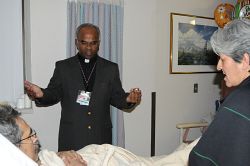Clinical pastoral education training teaches how to hear the needs of the sick and dying
Friday, Jul. 15, 2016

Intermountain Catholic
+ Enlarge
Fr. Lourduraj Gally Gregory, a certified hospital chaplain, is shown during a hospital visit in this Intermountain Catholic file photo.
SALT LAKE CITY — The first three weeks of the Clinical Pastoral Education course have given Dominican Brother Chrysostom Mijinke an idea of what visiting the sick and dying will be like for him as a transitional deacon and as a priest.
“I have done work in soup kitchens, visited the elderly in convalescent homes and done volunteer work, but this is my first experience being around sick and dying people,” said Brother Chrysostom, who is taking the summer CPE course at St. Mark’s Hospital. Three months of CPE training is required for Catholic seminarians; Brother Chrysostom, who is with the Western Dominican Province of the Most Holy Name of Jesus in Oakland, Calif., will enter his fourth year of studying for the priesthood.
He is staying at St. Catherine of Siena Newman Center while he takes the CPE course.
“I have been surprised at the power of just being with somebody and listening to their voice at their weakest state in life,” Brother Chrysostom said. “I have learned that death is not jarring like it is played out in the movies. What I have seen so far is a lot of peace comes around death; it actually feels natural to be around someone who is dying. A lot of little miracles happen around death – someone will suddenly get an idea to phone a person, or feel they need to go to the hospital, only to arrive 30 minutes before someone dies, or someone will hold on to life long enough to say ‘good-bye’ to a few people before they die.”
Instead of probing and prodding a patient and speaking about their physiological problems as do doctors and nurses, “I ask the person how he is doing,” he said. “I’ve been really shocked at how important that is when a person loses his power or freedom in life, or it doesn’t seem like there is anyone there to care for a person while he is sick. Caring about them can make a huge difference for these people.”
To help understand the patient, Brother Chrysostom discusses the conversations he has had with the patients with his peers and supervisor.
“Understanding where the patient is coming from is called intelligent listening,” explained Father Lourduraj Gally Gregory, a board-certified CPE hospital chaplain and pastor of St. Patrick Parish in Salt Lake City.
When Fr. Gally first arrived in Utah from India in 2004, he was assigned to the hospital ministry at the University of Utah Medical Center, Primary Children’s Hospital, the Huntsman Cancer Institute and University Neuropsychiatric Institute. In 2008, he became CPE board certified. He later became a chaplain at the George E. Wahlen Department of Veteran Affairs Medical Center in Salt Lake City, and a certified Pastoral Supervisor of Psychotherapy, and certified with the Archdiocese of Military Services.
“I had been visiting the same type of patients in the hospital and taking Communion to sick people in my parish from the time I became a priest in 1987,” he said. “Receiving the training gave me a qualitative difference in my ministry. I could then listen to them with more understanding and hear their needs to minister to them, to people of all denominations. I also learned to read what they weren’t saying by reading their expressions and body language.”
Fr. Gally also learned to look around the patient’s room for items such as flowers, books, or a Bible to pick up messages about the person, he said. “It is all part of being more observant. If family members are present, I engage them in conversation; we have to care for them as well. I tell them all I will pray for them.”
Fr. Gally visits patients in the Salt Lake Regional Hospital or wherever he is called, he said. His main purpose is to anoint the sick; only a Catholic priest can anoint the sick because it involves hearing a person’s confession. Anointing was known as Extreme Unction or last rites, but the rite’s original intention of healing was reestablished after Vatican II, he said.
“People wait too long before they call a priest; anointing is not for the dying, but it is important how a person dies,” Fr. Gally said. “When people die, they should die with peace of mind with God, with their family and their neighbor. Visiting the sick is very rewarding and fulfilling. I always feel happy when I can take care of these patients and their family members.”
For questions, comments or to report inaccuracies on the website, please CLICK HERE.
© Copyright 2024 The Diocese of Salt Lake City. All rights reserved.
© Copyright 2024 The Diocese of Salt Lake City. All rights reserved.

Stay Connected With Us